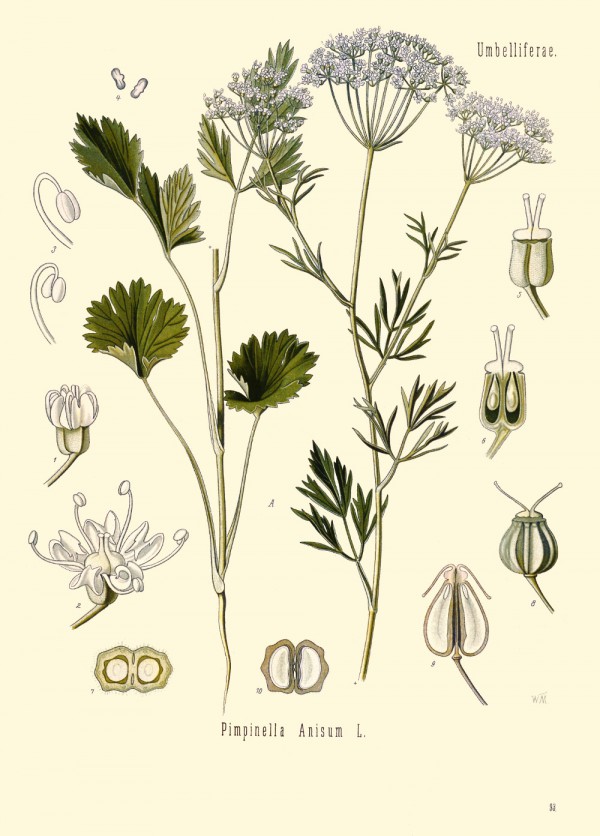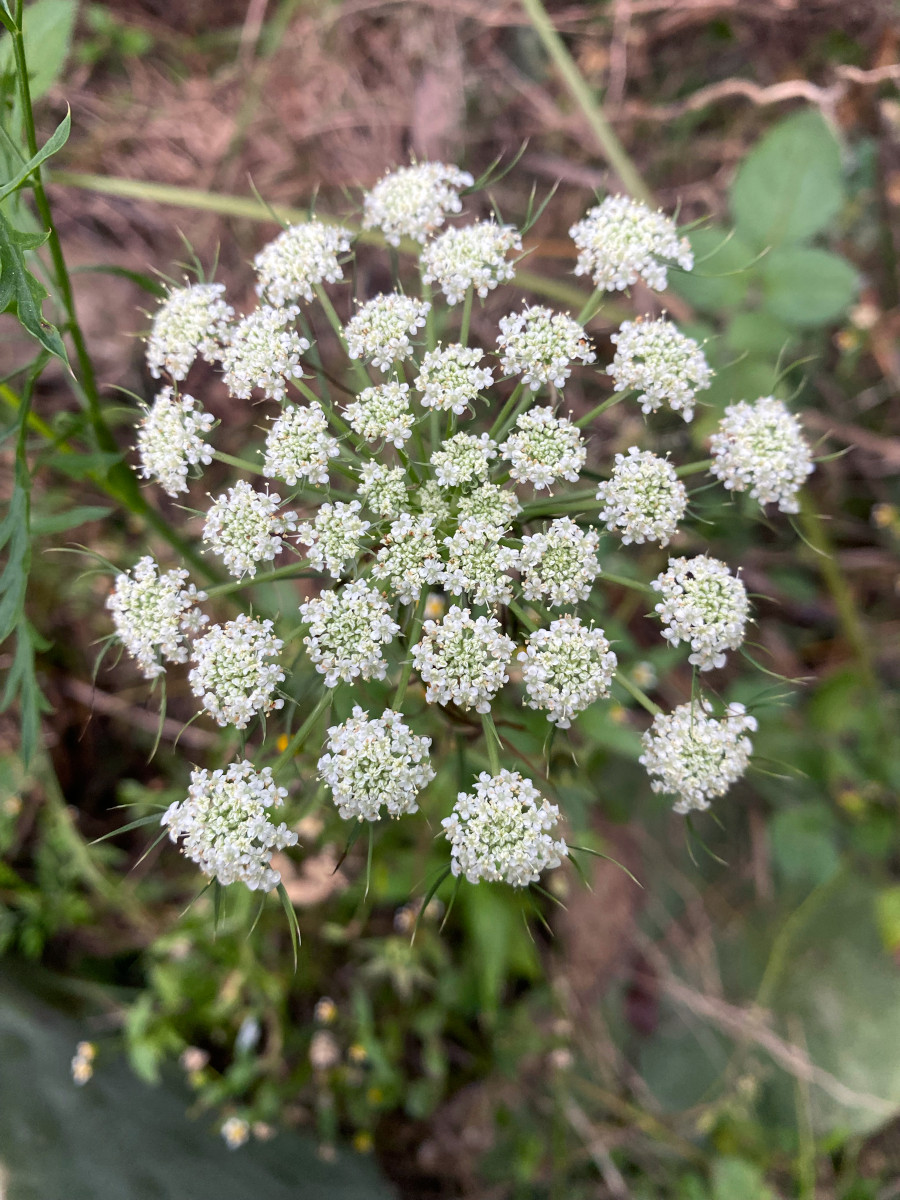Pimpinella anisum L. - syn. Pimpinella officinarum Moench; Anisum vulgare Gaertn.; Apium anisum Crantz, Carum anisum (L.) Baill. - Apiaceae
anise, Anis
Annual herb of the Mediterranean region, 0.10-0.50m high, widely cultivated in mild-temperate regions (Europe, Asia); sparsely shortly pubescent throughout, strongly aromatic; taproot slender; leaves heteromorphic: basal leaves simple, broad-ovate, upper ones feathery pinnate; umbels 1.5-6cm across, umbellules 0.5-1cm across, flowers white, tiny; fruit oblong-ovoid.
http://www.efloras.org/florataxon.aspx?flora_id=2&taxon_id=200015767
„In Western cuisine, anise is added to bread and baked goods. Mainly, however, anise is used for spirits and liqueurs, such as Sambuca, Raki, Ouzo, Arak, Absinthe, Pastis, Aguardiente, Chinchon and Anisette.“ wikipedia (de)
„The seeds, whole or ground, are used in a wide variety of regional and ethnic confectioneries, including black jelly beans, British aniseed balls, Australian humbugs, New Zealand aniseed wheels, Italian pizzelle, German Pfeffernüsse and Springerle, Austrian Anisbögen, Netherland muisjes, New Mexican bizcochitos, and Peruvian picarones. It is a key ingredient in Mexican atole de anís or champurrado, which is similar to hot chocolate, and it is taken as a digestive after meals in India.“ wikipeida (en)
Aniseed oil: Essential oil of the crushed seeds, prepared by steam distillation.
Constituents: (E)-anethole (91-96%), (Z)-anethole (0.3-0.4%), estragole (methylchavicol, 1-4%), p-anisaldehyde (0.5-0.9%), pseudoisoeugenyl 2-methylbutyrate (0.9%), epoxipseudoisoeugenyl 2-methylbutyrate (0.1-0.5%), himachalene (0.7-1%). The oil should be protected from light, otherwise trans-anethole isomerisation to cis-anethole occurs, and from air, to prevent oxidation to anisaldehyde.
Uses. Dyspeptic disorders, bronchitis. [Hagers Handbuch der Pharmazeutischen Praxis, Springer 2010]
„Supercritical fluid extraction (SFE) from aniseed using carbon dioxide was performed at 30 °C and pressures of 80−180 bar. The chemical composition of the SFE extract was determined by GC-MS; the quantitative analysis was done by GC-FID and TLC. The total amount of extractable substances or global yield (mass of extract/mass of feed) for the SFE process varied from 3.13 to 10.67% (mass). The solubilities of the anise essential oil in CO2 were 0.0110, 0.0277, 0.0143, and 0.0182 kg of solute/kg of CO2 at 80, 100, 140, and 180 bar, respectively. The major compounds identified and quantified in the extracts were anethole (∼90%), γ-himachalene (2-4%), p-anisaldehyde (<1%), methylchavicol (0.9-1.5%), cis-pseudoisoeugenyl 2-methylbutyrate (∼3%), and trans-pseudoisoeugenyl 2-methylbutyrate (∼1.3%).“
[Supercritical extraction of essential oil from aniseed (Pimpinella anisum L) using CO2: solubility, kinetics, and composition data., Rodrigues, V. M., Rosa, P. T., Marques, M. O., Petenate, A. J., Meireles, M. A. A., Journal of agricultural and food chemistry, Vol.51(6), 2003, 1518-1523]
„Variations in the essential oil composition of Pimpinella anisum L. fruits obtained from different geographical areas of Europe were determined using capillary GC and GC-MS techniques. The essential oil content of the samples was 10.0-53.6 mL kg−1 and did not confirm to the European Pharmacopoeia standard in 5 samples out of 14. A total of 21 compounds were identified and significant quantitative differences were observed among the samples. The major component was trans-anethole (76.9-93.7%); the other principal compounds in oils were γ-himachalene (0.4-8.2%), trans-pseudoisoeugenyl 2-methylbutyrate (0.4-6.4%), p-anisaldehyde (tr-5.4%) and methylchavicol (0.5-2.3%). The highest content of trans-anethole (>90%) was found in the samples from Greece, Hungary, Scotland, Lithuania, Italy, and Germany (2 samples). Essential oil of aniseed from Estonia was rich in γ-himachalene (8.2%) and trans-pseudoisoeugenyl 2-methylbutyrate (6.4%). The sample from France contained the highest amount of anisaldehyde (5.4%) comparing with other samples (0-3.1%). β-Bourbonene and α-farnesene are determined in anise oil for the first time.“
[Essential oil composition of Pimpinella anisum L. fruits from various European countries. Orav, A., Raal, A., Arak, E., Natural product research, Vol.22(3), 2008, 227-232]

Köhler,F.E., Medizinal Pflanzen, vol.2 t.93 (1890) plantgenera.org

Pimpinella anisum, Abancay, Andes, Peru (2025) © capacoscar CC BY-SA 4.0 inaturalist.org



